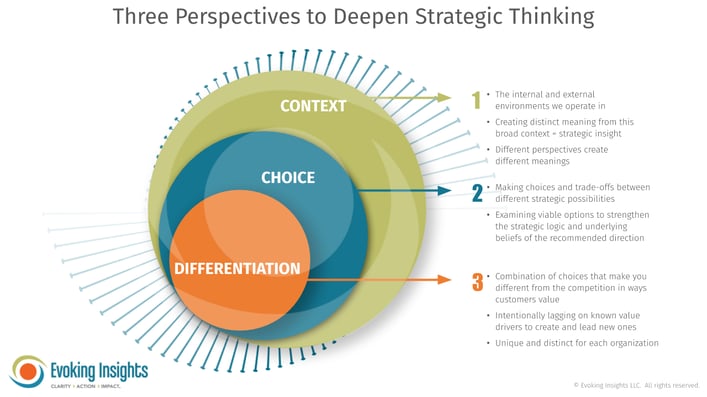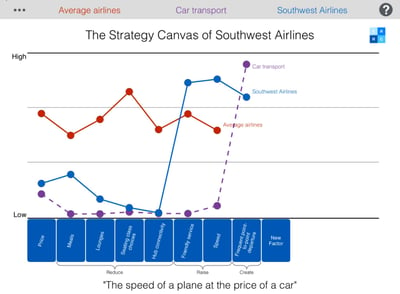Picture this: You have an idea, a new opportunity, or a recommendation for the organization. It's as clear as day to you what should be done. So you informally float your idea around to various leaders.
Some get excited. Others give you a "That's cool." A kind of cheerleading support, but no actual engagement to the point of endorsement or commitment. And then the worst response — something close to dismissal.
They clearly don't see what you see. Or are you the one missing something?
We have all been there. Is it the idea? Or the way we're presenting it that isn't having the desired impact? You believe this opportunity is vital for the future of the business. And you want to demonstrate that you can effectively make decisions that position the organization for the future, with deep strategic thinking skills.
You start with an internet search: "How to write a strategic business case." You already know many of the fundamentals —
- Describe the business need.
- Explain the objective.
- Outline the expected benefit.
- Articulate the strategic fit.
That last one can be tricky. Maybe there's an opportunity for more depth in your strategic thinking than a simple reference to an established strategic priority (e.g., entering a new market).
You think of various strategy tools and frameworks. While familiar with many of them, what is less clear is when they should or shouldn't be used. No one approach is a panacea. The right one is the one that is right for your circumstances. But which one is that?
And that is the thing about deepening strategic thinking skills and amplifying your strategic leadership. Tips, tricks, and formulas will only take us so far. They are designed to support strategic thinking and enable strategic insight. But how they are applied is what matters most. It will take time and experimentation to know which to use when — much like an artist deciding which tools and techniques to apply to their creation.
In the meantime, I have found three core perspectives that should always be considered in developing strategic recommendations. They aren't solutions but rather a starting point for curiosity and creation. They are like the three primary colors from which an entire spectrum of colors can be created.
 As you explore through each of the three lenses, how might you deepen your thinking to move beyond the known and familiar to distinct strategic insights that make a case for your idea? What might you discover? Perhaps an intuition revealed that you can now explain with a robust strategic logic.
As you explore through each of the three lenses, how might you deepen your thinking to move beyond the known and familiar to distinct strategic insights that make a case for your idea? What might you discover? Perhaps an intuition revealed that you can now explain with a robust strategic logic.
1. Context
There is always context to strategy. We often hear it referred to as "the bigger picture." When you put your recommendation into a broad context — both within the organization and the larger environment — you demonstrate to leaders that you aren't making decisions in a vacuum. That you can anticipate the long‑term implications of decisions and actions today on your strategic market position of tomorrow.
Your recommendation will factor in several key considerations:
- What is the business objective of your idea?
- How does it advance broader strategic objectives?
- How does it leverage or extend the key strengths and capabilities of the organization?
- How might other departments or functions be affected?
- How might the outside world respond – i.e., customers, competitors, regulators?
Various perspectives must be considered and continuously monitored. The strategic context is dynamic and ever‑changing, which can lead to a complex and sometimes ambiguous, even overwhelming, body of data to interpret and derive distinct strategic insights. Those ah‑ha moments when you see the world differently from that point forward.
Strategic insights can give you an edge over the competition. They often involve challenging assumptions about how things operate in your company and the industry to see things in a new distinct way. Take Southwest, turning a disadvantaged IT system into a strategic advantage by eliminating seat assignments to enable rapid turnaround times. This was one of many decisions that enabled competitive advantage.
Strategic insight is the critical ingredient often missing in the application of various strategy tools. It is our job to discern signals from the noise and create meaning from all the data. It is one of the most artful and creative parts of strategy. Thus, there is no formula to produce them. They emerge through discovery, curiosity, looking for patterns, connecting seemingly unconnected dots, and deciding what matters most.
Mastery is built through practice and experimentation. At first, you might feel like you're kicking up sand in the desert. You won't be able to see clearly. You will need to manage through the unsettling feelings associated with the emergent. Once the dust settles, however, and you're able to contribute at a higher level, you'll be glad you took the risk.
These insights become the strategic logic, or "why," for your choices and recommended actions. The deeper the thinking, the more robust the strategy.
2. Choice
Strategy is about choices, trade‑offs, and defining the unique value you deliver to specific customers in your competitive landscape. Strategy is a set of choices that positions an organization to win with customers and against the competition. To win, a company must choose to do some things and not others. A company that attempts to do all things or be all things to all people is destined to fail.
There is no right answer in strategy. No guarantee of success. The future is inherently uncertain, which can make narrowing your choices feel daunting. Most leaders like to keep their options open. But without choices, we can't focus. Our job as strategists is to increase the odds of success by thoughtfully evaluating strategic possibilities. Considering different scenarios and trade‑offs will deepen your strategic thinking on your recommended option. It helps you sort through the dynamic and ever‑changing environment. The anticipated long‑term strategic impact is your guide. Many options could (and do) deliver the desired strategic result — a powerful market position.
When you make your recommendation, frame it in the context of other options considered to achieve your desired future state. This will help decision‑makers understand the trade‑offs you considered and weigh in on the combination of choices and trade‑offs that best position the organization for the future. Be sure to create viable options.
If the choice is too easy, you haven't framed it well. Like an option that says, "We're going to focus on the customer." Who would pick an option that didn't?
In contrast, take Southwest. When they first came on the scene, I was not a fan. I liked my assigned seats, especially when I could afford the perks of business class: warm towels, champagne, and warm cookies on international flights. But Southwest said NO to serving any of these customer needs. They made a choice different from most of the competitive field and focused on a narrow set of customer needs: low cost, high flexibility, and rapid turnaround time. Their strategic clarity, resolve, and willingness to be different is what turned me and others into loyal customers.
Favorite Strategic Framework ‑ Choice: Play to Win
3. Differentiation
I believe the ultimate purpose of business strategy is to make choices that position you to be different from your competition in ways your core customers value.
Most profitable strategies (including Southwest's) are built on differentiation: offering customers something they value that competitors don't have, including products or services at a more accessible price point. Southwest offered me something I didn't even realize I valued (flexibility, reliability) like no one else in the industry.
Sounds simple enough. But in practice, most businesses don't quite get here. When a competitor is different and gaining an advantage, the tendency is to copy the competitor. This results in indistinct offerings and industry value curves, like the airline industry. Every airline is competing around the same value attributes. To beat the competition, companies ironically become mediocre and more like the competition.
 To stand out, we must become the exception, not the rule. To intentionally lag on known value drivers so that we can create new ones. And to do that is to risk being brilliant or completely wrong and rejected.
To stand out, we must become the exception, not the rule. To intentionally lag on known value drivers so that we can create new ones. And to do that is to risk being brilliant or completely wrong and rejected.
Let's focus on the possibility! Flex your strategic thinking skills and demonstrate how your recommendation creates, leverages, or extends a company's key competitive advantage. How is your recommendation creating distinct customer value?
Consider strategy guru Michael Porter’s simple guide. Will you:
- Perform different activities from rivals’ and/or
- Similar activities in different ways?
Favorite Strategic Framework ‑ Differentiation: Blue Ocean Strategy
Putting It in Practice
Reflect on a decision before you. Perhaps it’s a big ask you have around funding, resourcing, or relative priority across a team.
What strategic decisions are you trying to influence? Now consider these questions:
- What are the key beliefs and strategic insights driving your recommendation?
- How could you frame the options and deepen the rationale behind the recommended trade‑offs? What have you said NO to, so you can say “hell YES” to something else?
- How is your recommendation creating distinct customer value relative to competition?
- What could you add or adapt to be more effective in making your case and amplifying your strategic impact?
Be curious as you explore. Your first several ideas or answers to guiding questions will likely be in the known and familiar, playing by the rules of the current game. Peel away the underlying assumptions and beliefs of those first perspectives and dig deeper to see what might emerge.



